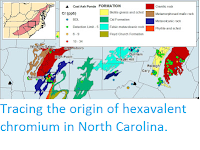The Palaeo-Tethys Ocean ran separated the continent of Gondwana from the landmasses that would become Europe and Asia during the Palaeozoic Era, opening during the Middle Cambrian and eventually closing with the formation of the Supercontinent of Pangea during the Permian/Triassic. The western part of this ocean is reasonably well understood, but the eastern extent is less well known, as much of the geology of the region has been distorted and overwritten by the Himalayan Orogeny, as the Indian Plate has impacted Eurasia from the south. The ocean probably passed along the southern margin of the South China Block (also known as the Yangtze Plate) (i.e. the southeastern coast of China), producing an area of rifting similar to that seen beneath the Red Sea today, but there is little evidence to support this.
In a paper published in the journal Acta Geologica Sinica on 27 February 2018, Hu Lisha, of the Collage of Marine Geosciences at the Ocean University of China, and the Laboratory for Marine Geology at the Qingdao National Laboratory for Marine Science and Technology, Du Yuansheng of the State Key Laboratory of Biogeology and Environmental Geology at the China University of Geosciences, and Xu Yajun, Wang Zhiwan, and Wang Chenghao, also of the Collage of Marine Geosciences at the Ocean University of China, describe the discovery of a volcanic tuff (ash) layer from Banchen in the Qinzhou area of the Guangxi Zhuang Autonomous Region of southeastern China, could provide evidence for subduction along the southern margin of the South China Block during the Palaeozoic.
Hu et al. report the discovery of a green tuff layer between layers of Devonian siliceous rocks, from which zircons were extracted for uranium/lead dating. Zircon is a mineral formed by the crystallisation of cooling magmas. When
it forms it often contains trace amounts of uranium, which decays into (amongst other things) lead at a
known rate. Since lead (which has a much lower precipitation temperature) will not have been present in the original
lava, it is possible to calculate the age of a zircon crystal from the
ratio between these elements.
(a) Tectonic framework of the East Asia; (b) Simplified geological map of the Qinfang Trough and location of the study area; (c) Photo for the Late Devonian chert and tuff; (d) Concordia diagram and cathodoluminescence (CL) images of representative zircons for the tuff sample. Hu et al. (2018).
Eighteen zircons were subjected to this analysis. Seven of them produced ages older than 600 million years, whereas eleven produced ages of between 380 and 350 million years, consistent with a Devonian or Carboniferous age for the tuff layer. The presence of much older zircons in the sample does not undermine this, as zircons are extremely tough, and are known to be able to endure repeated cycles of subduction and volcanic eruption, nor is the broad spread of ages found in the Palaeozoic zircons, as ash deposits often contain mineral grains aggregated over a long period before being erupted.
See also...
Follow Sciency Thoughts on Facebook.







